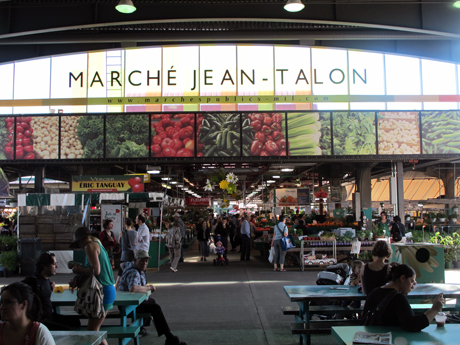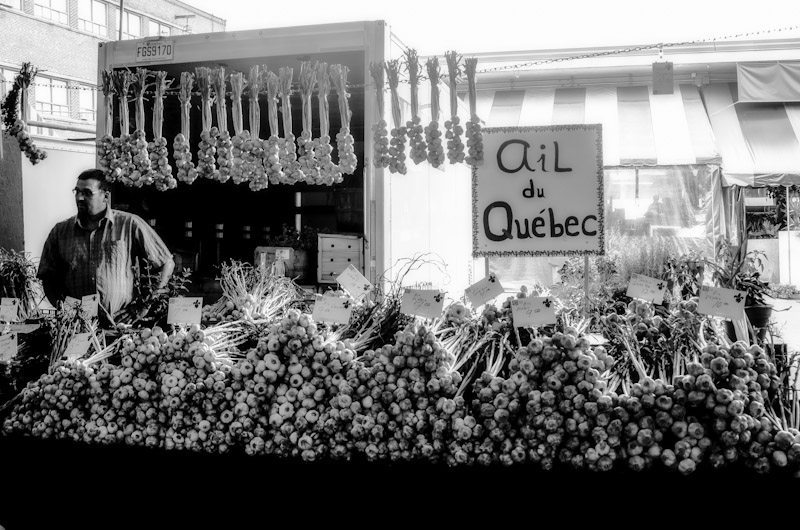
This backgrounder takes a look at the role of the Jean Talon Market in Montreal and how its presence within the city has contributed to a local food movement.
Eating locally encourages a food system within proximity that provides locals with sustainable produce. Fresh produce markets play a major role in Montreal's food culture. Four larger, well-known markets - Jean Talon, Atwater, Maissoneuve and Lachine - make up for most of the local produce that is sold in Montreal, making it easy for locals to eat the freshest, shortest-distance traveled food. Therein lays the outstanding belief and value that the local Jean Talon market stand behind - local farming and eating local in order to help Montreal sustain itself with fresh food.
A Look into the History of the Jean Talon Market

The Early Years
The renowned open air market has a rich history in Montreal. In 1931, the city of Montreal purchased what at one time a lacrosse playing field. Namely the most popular market known to Montrealers, the Jean Talon Market was inaugurated by then mayor, Camillien Houde, in 1933. In its infancy, awnings and long canopies from the north and south ends of the open market served as a hub for distributing local produce to clientele. The market then occupied a main building known as the "chalet". Aside from the market occupying the chalet, a Laval bus terminal and restaurant also shared the space until 1961. With a large clock heading the front of the building, the Jean Talon Market settled roots in its underdeveloped yet overpopulated neighborhood. Located in the Little Italy district, the market itself contained a certain European flair with its exterior setup, therefore drawing in local Italian-Canadians. Its defining characteristic being an open air market meant merchants built their own coverings during the winter months in order to keep selling their produce. Over the years, the chalet has served as a point for growth for the market. In 1943, six entrances made up the Jean Talon Market as it looks today. By 1983, heated coverings were put into place in the winter, and by 2004, the market would undergo an evolving transformation.
2004 - Today
The market evolved from a hidden neighborhood market into a dynamic and expansive area. Nestled and surrounded by residential buildings, Jean Talon Market's clientele grew exponentially. Though the market sees most of its traffic from May to October, it became necessary to expand the area for the growing number of vendors interested in displaying their produce. In 2004, an underground garage was constructed in order to open 450 parking spots, which has also made room for 22 new specialty shops in the market. Furthermore, the space created room for 30 new outdoor stales headed by Quebec farmers and artisans. Committed to bringing Montrealers the freshest food possible all year round, the market also went on to expand their winter mall - living up to their longstanding mission statement "To give Montrealers access to local produce in their public markets that relate to their values" (CGMPM).
Until 2006, a vehicle was welcome to traverse through the market streets, but since, a new policy has been implemented, allowing vehicles from Friday to Sunday only. This has been a popular and convenient characteristic of the market.
The Current Issues - Local Produce vs. Imported Produce

Many of the issues that surround the market have little to do with the market itself, but rather the values and beliefs it embodies. The economic, environmental and health benefits behind the idea that local produce is a better, more sustainable food system to live by encounters problems when it is pinned against the convenience and habit of importing produce. Imported produce is transported from out of country resources; this has become the main method of receiving produce in grocery stores. Between quality and cost, imported produce is not always cut out to be the best route. This has contributed to local farming becoming exceedingly popular.
Here is a look at a few outstanding and contrasting issues that have made local farming a widely supported option:
Economic
- Grocery stores rely on imported produce because food distributors have been able to meet the needs of most grocery store chains. Imported food is supposed to provide goods that are not available in a respective region. Even when fruits and vegetables are available in Quebec, grocery stores continue to import them. Last year, Hellmann's Canada produced a video in which they reviewed how much produce is imported into Canada. They revealed that within the last 15 years our food imports have increased by 160% while our population only grew by 15%. In order to transport all of that extra produce costs a great deal of money.
- Local farming aims to provide for a region with a sustainable approach. Local farmers grow and sell what is in season. Manageable baskets of vegetables are portioned off for purchase by vendors at the Jean Talon Market. This method allows farmers and vendors to regulate how much produce is necessary to meet the local's needs. This also helps to control vegetable waste since farmers can only sell what they have grown. Transportation costs are also minimal seeing as local produce travels far less distance than imported produce. Seasonal produce that has traveled a small distance will always cost less than the average cost for the same item in a grocery store. Buying locally grown food from local farmers directly supports the economy while encouraging a sustainable food system.
Environmental
- Mounds of excess produce in grocery stores have led Canadians to waste more vegetables. According to Statistics Canada, vegetables top the list for food waste. This accounts for 51% of the total food wasted in Canada. Food waste highly contributes to pollution and global warming. The most harmful damage caused by imported food comes from transportation. Imported produce begins its journey outside of the country, then to a distributing plant and onto a truck or plane before it even reaches its intended destination. Transporting produce requires an enormous amount of fuel considering most produce is imported, which causes damage to the environment.
- Local farming practices food growth and selling within the region it occupies. Buying produce that is grown in province relies on less fuel and cost to reach consumers. In Monique Beaudin's Gazette article, "Bumper crop - in the city", the effects of local and urban gardens are addressed: "It reduces heat-island effect, where local temperatures are high because of concentrations of concrete or asphalt. It also shortens the distances that food has to be shipped to reach people, cutting vehicle pollution. And it encourages biodiversity by introducing plants and vegetables into the city, creating habitats for a diverse range of creatures and a food source for birds and pollinating insects, such as bees and butterflies"
Buying local produce from a market such as Jean Talon encourages a population to grow their own food. Beaudin's article also showcased an urban garden in the middle of Montreal called the Jardin du Marche rue Ontario. This one garden provides neighborhood locals with vegetables and herbs. Supporting local crops promotes a self sufficient attitude. In addition, Montreal harbors 97 community gardens that are in constant demand. Local planting becomes more appealing to a population when quality, taste and handling all left in their control which contributes to a healthier environment in return.
Health
- Imported food has the highest risk for contamination. Because imported food travels far greater distances than local food, it exposes produce to chemicals, toxins, and mishandling between facilities. In an assessment report conducted by the Canadian Food Inspection Agency in 2010, the Fresh Fruit and Vegetable Program did not consistently receive import documents containing facts about produce items that need specific inspection. Without these documents, inspection staff members do not have any basis for sampling produce for analysis. If imported produce does not follow strict guidelines for inspection, then contamination becomes a major issue for consumers. Slips on food inspection and safety at the Canadian border are a reality and in turn compromises the health of those who purchase imported food. During the transportation process, imported produce also gets sprayed with a film of vegetables oils and various waxes in order to prevent them from bruising and brightening their color to have them appear more attractive.
- Attaining fresh produce all year long is important to our health. When certain produce items are not available due to climate conditions or season, the belief of the markets is to preserve what you can. Eating seasonally helps promote a healthier lifestyle. Food that is picked in season and preserved is richer in nutrients. Preservation is encouraged at the market seeing as local growers concentrate on providing seasonal produce. Preserving fresh foods while they are still in season ensures that locally grown food can still be available during those months when an item is not in season. As produce goes in and out of season, there is no shortage of new produce to discover, as well as preserve. Between canning, freezing, and pickling, options for preserving foods are also vast.
Another health benefit to buying from produce from the market is the relationship locals adopt with their vendors. Every year in late August and into September, Jean Talon Market vendors take down names and numbers of customers who want to reserve bushels of tomatoes, corn, strawberries, etc. for the coming harvest weeks. Vendors also participate in teaching locals about their produce items and different methods of storage, preparation and preservation, all attributing benefactors to a healthier lifestyle. The opportunity to know the person who has grown your food, handled your food and knows how to get the most out of it exists at the market.
Future Implications: How Does the Jean Talon Market Affect Montreal's Future?

In an informative article in the Montreal Gazette, "Radical roots", local farmer Jacques Remillard is featured as one of the many vendors who want Montrealer's to be introduced to fresh and new produce by offering samples of them: "Pairing knife at hand, Jacques spends his autumn days at the market bundled up in wool and flannels, slicing off slivers of bright pink Moroccan radish, pink turnips or black-skinned radishes for customers to try. He's a one man marketing board for varieties of strange and radical roots" (Semenak). This experience is unique to the market. In order to be further educated about local fresh food and its benefits, sampling it and learning about it from the person who grew it effectively brings you closer to the food you eat.
The Jean Talon Market's presence within the city encourages locals to eat regionally and to maintain their produce needs by adopting a seasonal attitude towards consuming. In turn, the market relays these affects to Montreal as a whole:
- Rely less on imported produce
- Increases urban agriculture
- Encourages the notion - Buy local when we can, and import when we must
- Promotes a self-sufficient community
- Demonstrates how available and affordable local produce actually is
- Supports the local economy and the environment
The Jean Talon Market plays an integral role in inspiring local chefs to showcase locally grown produce. Olivier Perret, chef of the Montreal restaurant, Sofitel, creates a weekly menu from his regular Thursday trips to the Jean Talon Market. His Menu du Marche consists of local produce that is bought from the market. This is another way that the market's influence on Montreal is showcased. Vendors provide and educate customers like chefs who in turn teach their customers about allowing the seasons to create the menus. This circle of local food education passes on the markets values to Montrealers and tourists alike.
The future of the Jean Talon Market is strongly held by the beliefs and values it presents with the bounty of locally grown Quebec produce it showcases. The market brings tradition and availability to Montreal after 79 years of continued growth and expansion.
Leave a comment